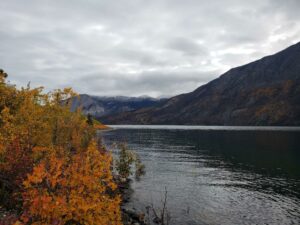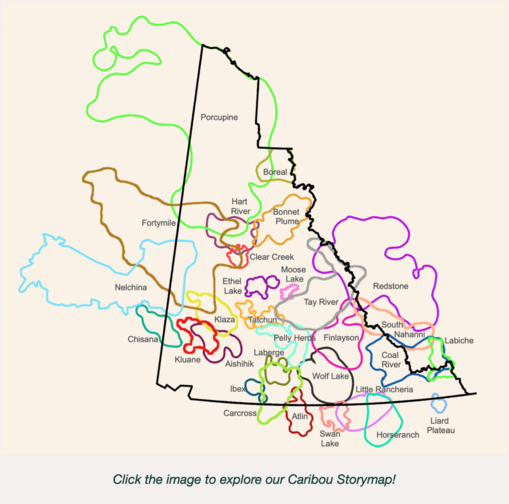Written By Kirsten Reid – Conservation Biologist

Photo by / par Conor Curtis
This story is from our friends at the Yukon Conservation Society and was part of their March Tread Lightly Newsletter. Since 1968, the Yukon Conservation Society has been advocating, educating, and conducting research on Yukon environmental issues. You can read the full edition of that newsletter here.
Caribou are an iconic species in northern ecosystems and have significant cultural and dietary importance for many Indigenous and non-Indigenous people.
Caribou represent healthy and intact landscapes. Since herds need large areas to eat, live, and migrate through, a landscape teeming with caribou generally indicates that it is healthy and productive.
In the Yukon, we have 30 herds of Northern Mountain, Boreal, and Migratory caribou. These herds all have distinct ranges and needs and a different history of interacting with humans.
In addition to being home for many caribou, the Yukon is also the location of much industrial development.
The Yukon currently has 2 operating hard rock mines as well as numerous exploration and clean-up projects.

All of these projects have associated surface disturbances, some of which are of significant size. These surface disturbances impact the movement and behaviour of caribou.
In southern Canada, there are many documented examples of caribou herds responding negatively to industrial disturbances.
In the Yukon, the relationship between caribou health and industrial disturbances remains largely understudied.
However, in the age of ongoing industrial development and increased threats to biodiversity, understanding the effects that human activities may have on wildlife is key to protecting wildlife and planning for future land use and development.
An initial step to doing this is to know the current (or recent) number of individuals in each herd. We also need detailed maps of key habitat areas within each herd’s range, where caribou both rut and spend the winter.
Two recent projects from the Yukon Conservation Society have highlighted some of these knowledge or information gaps.
First, in our interactive summary of the caribou herds in the Yukon(link is external), you can see that some herds have not been surveyed in 30-40 years (the Bonnet Plume herd was last surveyed in 1982; the Moose Lake herd was last surveyed in 1991 when the population was 300 individuals). To make informed decisions about caribou conservation, we need current baseline data.
Second, we looked at how much of the annual, winter, and rutting ranges of the Clear Creek Caribou Herd have been permitted for industrial activity.
After we accounted for the extended zone of influence that industrial footprints have on caribou behaviour, up to 100% of these key areas have already been permitted for mining activities.
Currently, the data required for us to map how much mining-related disturbance has actually occurred within these areas are not available.
There are three initiatives that we see as being able to help properly protect caribou herds in the Yukon. Along with other partners, YCS is working to champion these solutions:
1 – We need current population estimates and range maps (including key areas) for each herd. Many of the herds have recent and regular information but this is required for all herds in order to make accurate conservation decisions.
2 – Herd ranges and/or key areas need legal protection. This is particularly important for herds of conservation concern. Currently, key area status does not grant any legal protection.
3 – To help address the conservation status of herds, Yukon needs its own Species at Risk Act(link is external). This legislation would be beneficial to Yukon species other than caribou, including a range of endemic (or ‘only found in the Yukon’) species as well as species that are particularly threatened by changing landscapes from both industrial activity and ongoing climate change.
